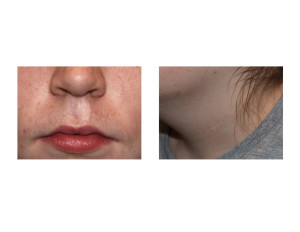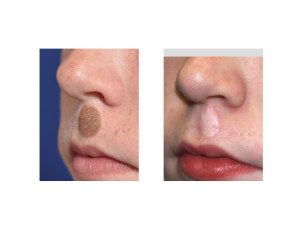Background: The congenital melanocytic nevus is one form of a mole that is present at birth. It occurs in about 1% of all births and occurs about 15% of the time on the face. It usually appears as a very distinct brown-colored lesion whose color is very homogenous. One of its distinct features is that it is associated with hair that is usually dark in color.
The melanocytic nevus grows proportionally as the child grows and will usually become thicker and raised above the surrounding skin’s surface. Its hair growth becomes greater after puberty and the hair growth may become darker in color. Very large congenital nevi are at higher risk for malignant conversion into melanoma. And for this reason early excision is standard practice to eliminate this potential risk.
Melanocytic nevi are classified by size based on diameter. Small size are those that are less than 2 cms. But when they occur on the lip a 1 or 2 cm nevi can be considered large when considering how to reconstruct it after excision.
Case Study: This 13 year-old female was born with congenital nevus on her lip. It grew proportionately with her and developed a lot of hair growth. It was a source of ridicule for her in school and requires regular hair trimming. She was finally ready to have it removed. Because of its size, treatment options included serial excision, total excision with skin grafting and excision with local flap reconstruction.


Highlights:
1) Congenital lip nevi are present at birth and are usually associated with extensive hair growth as the child develops.
2) Large lip nevi can not be primarily closed after total excision without significant lip distortion.
3) Complete excision of congenital lip nevi requite full thickness skin grafting to prevent transverse lip deformities/constriction.
Dr. Barry Eppley
Indianapolis, Indiana



